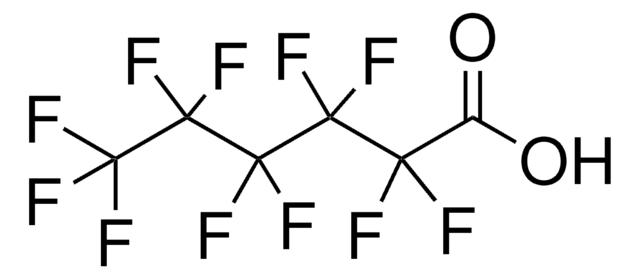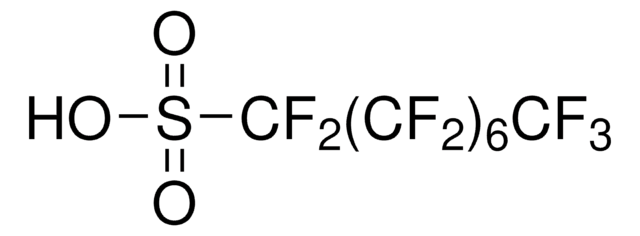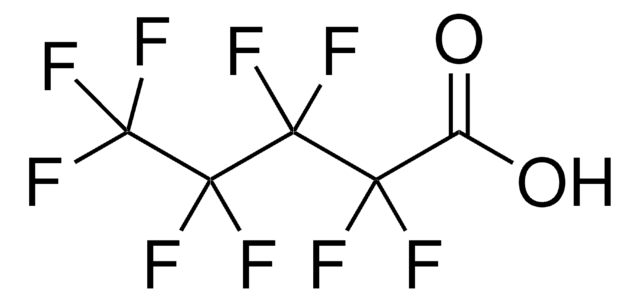43996
Perfluoroheptanoic acid
analytical standard
Synonym(s):
Tridecafluoroheptanoic acid, PFAS, Perfluoroheptanoic acid
About This Item
Recommended Products
grade
analytical standard
agency
suitable for ASTM® 7968
suitable for ASTM® 7979
suitable for DIN 38407-42
suitable for EPA 1633
suitable for EPA 533
suitable for EPA 537.1
suitable for EPA 8327
suitable for EPA ACB B21-02
suitable for EPA ACB B23-05b
suitable for EPA OTM-45
suitable for ISO 21675 2019
reg. compliance
suitable for FDA C-010.02
assay
≥98.0% (GC)
shelf life
limited shelf life, expiry date on the label
refractive index
n20/D 1.306 (lit.)
bp
175 °C/742 mmHg (lit.)
density
1.792 g/mL at 25 °C (lit.)
storage temp.
2-8°C
SMILES string
OC(=O)C(F)(F)C(F)(F)C(F)(F)C(F)(F)C(F)(F)C(F)(F)F
InChI
1S/C7HF13O2/c8-2(9,1(21)22)3(10,11)4(12,13)5(14,15)6(16,17)7(18,19)20/h(H,21,22)
InChI key
ZWBAMYVPMDSJGQ-UHFFFAOYSA-N
Looking for similar products? Visit Product Comparison Guide
Related Categories
General description
PFCAs have been used widely as wetting agents, lubricants, corrosion inhibitors, foam fire extinguishants, and in the manufacture of fluoropolymers due to their highly surface-active nature, chemical and thermal stabilities. Because of their widespread use and their persistence in the environment, many PFAS are found in the blood of people and animals all over the world and are present at low levels in a variety of food products and the environment. Animal testing has revealed a number of toxic effects caused by these compounds, particularly with regard to tumor growth and reproductive toxicity.
Perfluoroheptanoic acid is included in a variety of norms to be tested in soil, water, wastewater, sludge, food, and textiles/leather.
- ASTMD7968-17a: Determination of Polyfluorinated Compounds in Soil
- ASTMD7979-20: Determination of Per- and Polyfluoroalkyl Substances in Water, Sludge, Influent, Effluent, and Wastewater
- EPA533, EPA 537.1: Determination of per and polyfluoroalkyl substances in drinking water
- FDAC-010.01: Determination of 16 Perfluoroalkyl and Polyfluoroalkyl Substances in Food (matrices: lettuce, milk, fish)
- ISO21675: Determination of perfluoroalkyl and polyfluoroalkyl substances in water(non-filtrated e.g. drinking water, natural water, wastewater containing less than 2 g/L solid particulate material
- DINEN 23702: Determination of non-volatile extractable perfluorinated and polyfluorinated substances in leather and coated leather
- DIN38407-42: Determination of selected polyfluorinated compounds in water
- DIN 38414-14: Determination of selected polyfluorinated compounds in sludge, compost, and soil
Application
- Decomposition of perfluorooctanoic acid (PFOA) under sonication-assisted photocatalysis using TiO2
- To study the toxicokinetics between perfluoroheptanoic acid (PFHA), perfluorooctanoic acid (PFOA), perfluorononanoic acid (PFNA), and perfluorodecanoic acid (PFDA) in male and female rats
- To assess the acute toxicity of perfluorohexanoic acid, perfluoroheptanoic acid, perfluorooctanoic acid, perfluorononanoic acid, and perfluorodecanoic acid using eukaryotic cell lines, bacteria, and enzymatic assays
- Determination of 15 selected synthetic cannabinoids and their metabolites by micellar electrokinetic chromatography-mass spectrometry using perfluoroheptanoic acid-based micellar phase
- To study the signal suppression in liquid chromatography-electrospray ionization mass spectrometry using volatile ion-pairing reagents like trifluoroacetic acid, heptafluorobutanoic acid, and perfluoroheptanoic acid
Legal Information
signalword
Danger-Danger
flash_point_f
Not applicable
flash_point_c
Not applicable
Choose from one of the most recent versions:
Certificates of Analysis (COA)
Don't see the Right Version?
If you require a particular version, you can look up a specific certificate by the Lot or Batch number.
Already Own This Product?
Find documentation for the products that you have recently purchased in the Document Library.
Our team of scientists has experience in all areas of research including Life Science, Material Science, Chemical Synthesis, Chromatography, Analytical and many others.
Contact Technical Service









